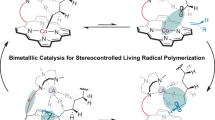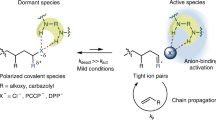Access this chapter
Tax calculation will be finalised at checkout
Purchases are for personal use only
Similar content being viewed by others
Abbreviations
- α-AL:
-
α-Angelica lactone
- γ-BL:
-
γ-Butyrolactone
- γ-MMBL:
-
γ-Methyl-α-methylene-γ-butyrolactone
- γ-VL:
-
γ-Valerolactone
- ε-CL:
-
ε-Caprolactone
- nBA:
-
n-Butyl acrylate
- BHT:
-
Butylated hydroxytoluene
- BINAP:
-
2,2′-Bis(diphenylphosphino)-1,1′-binaphthyl
- CLP:
-
Classical Lewis pair
- Cp:
-
η 5-Cyclopentadienyl
- CP-1:
-
(S)-(−)-(1,1′-Binaphthalene-2,2′-diyl)bis(diphenylphosphine)
- CP-2:
-
(−)-1,2-Bis[(2S,5S)-2,5-diisopropylphospholano]benzene
- CP-3:
-
(S,S)-1,2-Bis[α-naphthyl(phenylphosphino)]ethane
- CP-4:
-
(2S,3S)-(−)-2,3-Bis(diphenylphosphino)butane
- DEVP:
-
Diethyl vinylphosphonate
- DMAA:
-
N,N-Dimethylacrylamide
- DMF:
-
N,N-Dimethylformamide
- DPAA:
-
N,N-Diphenylacrylamide
- EBI:
-
Ethylene bis(η 5-1-indenyl)
- El:
-
Electrophile
- FG:
-
Functional group
- FLP:
-
Frustrated Lewis pair
- Flu:
-
η 5- or η 3-Fluorenyl
- FMA:
-
Furfuryl methacrylate
- GPC:
-
Gel-permeation chromatography
- IMes:
-
1,3-Bis(2,4,6-trimethylphenyl)imidazol-2-ylidene
- It:
-
Isotactic (mm)
- ItBu:
-
1,3-Di-tert-butylimidazol-2-ylidene
- LA:
-
Lewis acid
- LB:
-
Lewis base
- LP:
-
Lewis pair
- LPP:
-
Lewis pair polymerization
- M:
-
Monomer
- MAO:
-
Methylaluminoxane
- MBL:
-
α-Methylene-γ-butyrolactone
- Mes:
-
Mesityl (2,4,6-trimethylphenyl)
- MMA:
-
Methyl methacrylate
- M n (M w):
-
Number (weight) average molecular weight
- MW:
-
Molecular weight
- MWD:
-
Molecular weight distribution
- NHC:
-
N-Heterocyclic carbene
- Nu:
-
Nucleophile
- P2-tBu:
-
1-tert-Butyl-2,2,4,4,4-pentakis(dimethylamino)-2λ5,4λ5-catenadi(phosphazene)
- P4-tBu:
-
1-tert-Butyl-4,4,4-tris(dimethylamino)-2,2-bis[tris(dimethylamino)-phosphoranylidenamino]-2λ5,4λ5-catenadi(phosphazene)
- PDI:
-
Polydispersity index
- PDMAA:
-
Poly(N,N-dimethylacrylamide)
- PMMA:
-
Poly(methyl methacrylate)
- RT:
-
Room temperature
- St:
-
Syndiotactic (rr)
- THF:
-
Tetrahydrofuran
- TOF:
-
Turn-over frequency
- TPT:
-
1,3,4-Triphenyl-4,5-dihydro-1H-1,2,4-triazol-5-ylidene
- TS:
-
Transition state
- VT:
-
Variable temperature
References
Zhang Y, Miyake GM, Chen EYX (2010) Alane-based classical and frustrated Lewis pairs in polymer synthesis: rapid polymerization of MMA and naturally renewable methylene butyrolactones to high molecular weight polymers. Angew Chem Int Ed 49:10158–10162
Zhang Y, Miyake GM, John MG, Falivene L, Caporaso L, Cavallo L, Chen EYX (2012) Lewis pair polymerization by classical and frustrated Lewis pairs: acid, base and monomer scope and polymerization mechanism. Dalton Trans 41:9119–9134
Stephan DW, Erker G (2010) Frustrated Lewis pairs: metal-free hydrogen activation and more. Angew Chem Int Ed 49:46–76
Erker G (2011) Organometallic frustrated Lewis pair chemistry. Dalton Trans 40:7475–7483
Stephan DW (2008) “Frustrated Lewis pairs”: a concept for new reactivity and catalysis. Org Biomol Chem 6:1535–1539
McCahill JSJ, Welch GC, Stephan DW (2007) Reactivity of frustrated Lewis pairs: three-component reactions of phosphines, a borane, and olefins. Angew Chem Int Ed 46:4968–4971
Johnston DS (1982) Macrozwitterionic polymerization. Adv Polym Sci 42:51–106
Baskaran D, Müller AHE (2007) Anionic vinyl polymerization – 50 years after Michael Szwarc. Prog Polym Sci 32:173–219
Baskaran D (2003) Strategic developments in living anionic polymerization of alkyl (meth)acrylates. Prog Polym Sci 38:521–581
Chen EYX (2009) Coordination polymerization of polar vinyl monomers by single-site metal catalysts. Chem Rev 109:5157–5214
Chen EYX, Mark TJ (2000) Cocatalyst for metal-catalyzed olefin polymerization: activators, activation processes, and structure-activity relationships. Chem Rev 100:1391–1434
McCahill JSL, Welch GC, Stephan DW (2009) Sterically hindered phosphine and phosphonium-based activators and additives for olefin polymerization. Dalton Trans 8555–8561
Murahashi S, Nozakura SI, Hatada K, Takeuchi S, Aoki T (1960) Polymerizability of vinyl monomers with organometallic compounds. Sen-iken Nenpo 13:99–104
Ikeda M, Hirano T, Tsuruta T (1971) Organometallic compound with Lewis base. I. Polymerization of vinyl-compounds by organometallic compound/Lewis base complex. Makromol Chem 150:127–135
Kitayama T, Masuda E, Yamaguchi M, Nishiura T, Hatada K (1992) Syndiotactic-specific polymerization of methacrylates by tertiary phosphine-triethylaluminum. Polym J 24:817–827
Kitayama T, Lijima T, Nishiura T, Hatada K (1992) Highly efficient block copolymerization of methyl and t-butyl methacrylates by an incomplete and slow initiation system. Polym Bull 28:327–331
Chen EYX (2012) Tris(pentafluorophenyl)alane. e-Encycl Reag Org Syn. doi: 10.1002/047084289X.rn01382
Chen EYX, Kruper WJ, Roof GR, Wilson DR (2001) Double activation of constrained geometry and ansa-metallocene group 4 metal dialkyls: synthesis, structure, and olefin polymerization study of mono- and dicationic aluminate complexes. J Am Chem Soc 123:745–746
Chen EYX, Abboud KA (2000) Unusual weakly coordinating anion reactivity in metallocene chemistry. Formation of tantalocene cation-dinuclear anion pairs. Organometallics 19:5541–5543
Bolig AD, Chen EYX (2001) Reversal of polymerization stereoregulation in anionic polymerization of MMA by chiral metallocene and non-metallocene initiators: a new reaction pathway for metallocene-initiated MMA polymerization. J Am Chem Soc 123:7943–7944
Chakraborty D, Chen EYX (2002) Neutral olefin polymerization activators as highly active catalysts for ROP of heterocyclic monomers and for polymerization of styrene. Macromolecules 35:13–15
Hair GS, Cowley AH, Jones RA, McBurnett BG, Voigt A (1999) Arene complexes of Al(C6F5)3. Relationship to a déjà vu silylium ion. J Am Chem Soc 121:4922–4923
Chen EYX (2009) Transformation of polymerization of polar vinyl monomers by discrete and hybrid metal catalysts. Dalton Trans 8784–8793
Sajid M, Stute A, Cardenas AJP, Culotta BJ, Hepperle JAM, Warren TH, Schirmer B, Grimme S, Studer A, Daniliuc CG, Fröhlich R, Petersen JL, Kehr G, Erker G (2012) N, N-Addition of frustrated Lewis pairs to nitric oxide: an easy entry to a unique family of aminoxyl radicals. J Am Chem Soc 134:10156–10168
Biju AT, Padmanaban M, Wurz NE, Glorius F (2011) N-Heterocyclic carbene catalyzed umpolung of Michael acceptors for intermolecular reactions. Angew Chem Int Ed 50:8412–8415
Matsuoka SI, Ota Y, Washio A, Katada A, Ichioka K, Takagi K, Suzuki M (2011) Organocatalytic tail-to-tail dimerization of olefin: umpolung of methyl methacrylate mediated by N-heterocyclic carbene. Org Lett 13:3722–3725
Zhang Y, Chen EYX (2012) Conjugate-addition organopolymerization: rapid production of acrylic bioplastics by N-heterocyclic carbenes. Angew Chem Int Ed 51:2465–2469
Ning Y, Cooney MJ, Chen EYX (2005) Polymerization of MMA by oscillating zirconocene catalysts, diastereomeric zirconocene mixtures, and diastereospecific metallocene pairs. J Organomet Chem 690:6263–6270
Stojcevic G, Kim H, Taylor NJ, Marder TB, Collins S (2004) Methacrylate polymerization using a dinuclear zirconocene initiator: a new approach for the controlled synthesis of methacrylate polymers. Angew Chem Int Ed 43:5523–5526
Zhang Y, Chen EYX (2008) Controlled polymerization of methacrylates to high molecular weight polymers using oxidatively activated group transfer polymerization initiators. Macromolecules 41:36–42
Zhang Y, Chen EYX (2008) Structure–reactivity relationships in bimolecular-activated monomer polymerization of (meth)acrylates using oxidatively activated group 14 ketene acetals. Macromolecules 41:6353–6360
Rodriguez-Delgado A, Chen EYX (2005) Single-site anionic polymerization. Monomeric ester enolaluminate propagator synthesis, molecular structure, and polymerization mechanism. J Am Chem Soc 127:961–974
Iglesias-Sigüenza J, Alcarazo M (2012) Fullerenes as neutral carbon-based Lewis acids. Angew Chem Int Ed 51:2–4
Li H, Risko C, Seo JH, Campbell C, Wu G, Brédas JJ, Bazan GC (2011) Fullerene–carbene Lewis acid–base adducts. J Am Chem Soc 133:12410–12413
Ullrich M, Seto KSH, Lough AJ, Stephan DW (2009) 1,4-Addition reactions of frustrated Lewis pairs to 1,3-dienes. Chem Commun 2335–2337
Dureen MA, Stephan DW (2009) Terminal alkyne activation by frustrated and classical Lewis acid/phosphine pairs. J Am Chem Soc 131:8396–8397
Xu BH, Kehr G, Fröhlich R, Wibbeling B, Schirmer B, Grimme S, Erker G (2011) Reaction of frustrated Lewis pairs with conjugated ynones-selective hydrogenation of the carbon-carbon triple bond. Angew Chem Int Ed 50:7183–7186
Ning Y, Zhu H, Chen EYX (2007) Remarkable Lewis acid effects on polymerization of functionalized alkenes by metallocene and lithium ester enolates. J Organomet Chem 692:4535–4544
Chase PA, Stephan DW (2008) Hydrogen and amine activation by a frustrated Lewis pair of a bulky N-heterocyclic carbene and B(C6F5)3. Angew Chem Int Ed 47:7433–7437
Holschumacher D, Bannenberg T, Hrib CJ, Jones PG, Tamm M (2008) Heterolytic dihydrogen activation by a frustrated carbene-borane Lewis pair. Angew Chem Int Ed 47:7428–7432
Timoshkin AY, Frenking G (2008) Gas-phase Lewis acidity of perfluoroaryl derivatives of group 13 elements. Organometallics 27:371–380
Vanka K, Chan MSW, Pye CC, Ziegler T (2000) A density functional study of ion-pair formation and dissociation in the reaction between boron- and aluminum-based Lewis acids with (1,2-Me2Cp)2ZrMe2. Organometallics 19:1841–1849
Chen EYX (2009) Ion-pairing polymerization. Comments Inorg Chem 30:7–27
Chen EYX, Cooney MJ (2003) Amphicatalytic polymerization: synthesis of stereomultiblock poly(methyl methacrylate) with diastereospecific ion pairs. J Am Chem Soc 125:7150–7151
Ning Y, Chen EYX (2006) Diastereospecific ion-pairing polymerization of functionalized alkenes by metallocene/Lewis acid hybrid catalysts. Macromolecules 39:7204–7215
Spaether W, Klaß K, Erker G, Zippel F, Fröhlich R (1998) Formation of group 4 metallocene-enolate·B(C6F5)3 adducts and their role as initiators in the rapid polymerization of the functionalized olefin methyl vinyl ketone. Chem Eur J 4:1411–1417
Zhang Y, Caporaso L, Cavallo L, Chen EYX (2011) Hydride-shuttling chain transfer and stereoregulation in methacrylate polymerization catalyzed by metallocenium enolate metallacycle–hydridoborate ion pairs. J Am Chem Soc 133:1572–1588
Acknowledgments
The study carried out at Colorado State University was supported by the National Science Foundation (CHE 1150792). The author thanks Prof. Tatsuki Kitayama for providing a copy of [13], which was an internal report written in Japanese and archived in the Macromolecular Department of Osaka University.
Author information
Authors and Affiliations
Corresponding author
Editor information
Editors and Affiliations
Rights and permissions
Copyright information
© 2012 Springer-Verlag Berlin Heidelberg
About this chapter
Cite this chapter
Chen, E.YX. (2012). Polymerization by Classical and Frustrated Lewis Pairs. In: Erker, G., Stephan, D. (eds) Frustrated Lewis Pairs II. Topics in Current Chemistry, vol 334. Springer, Berlin, Heidelberg. https://doi.org/10.1007/128_2012_372
Download citation
DOI: https://doi.org/10.1007/128_2012_372
Published:
Publisher Name: Springer, Berlin, Heidelberg
Print ISBN: 978-3-642-37758-7
Online ISBN: 978-3-642-37759-4
eBook Packages: Chemistry and Materials ScienceChemistry and Material Science (R0)




